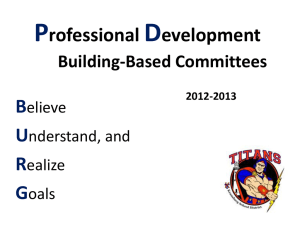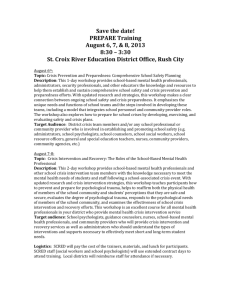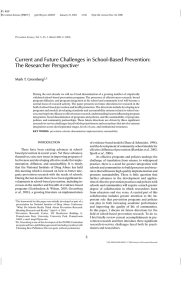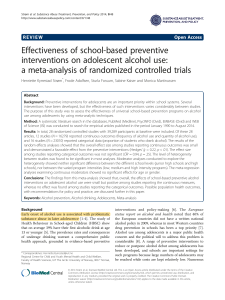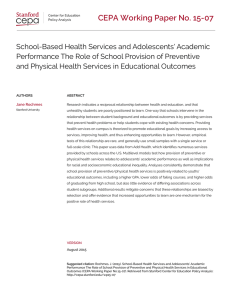Document 10480475
advertisement
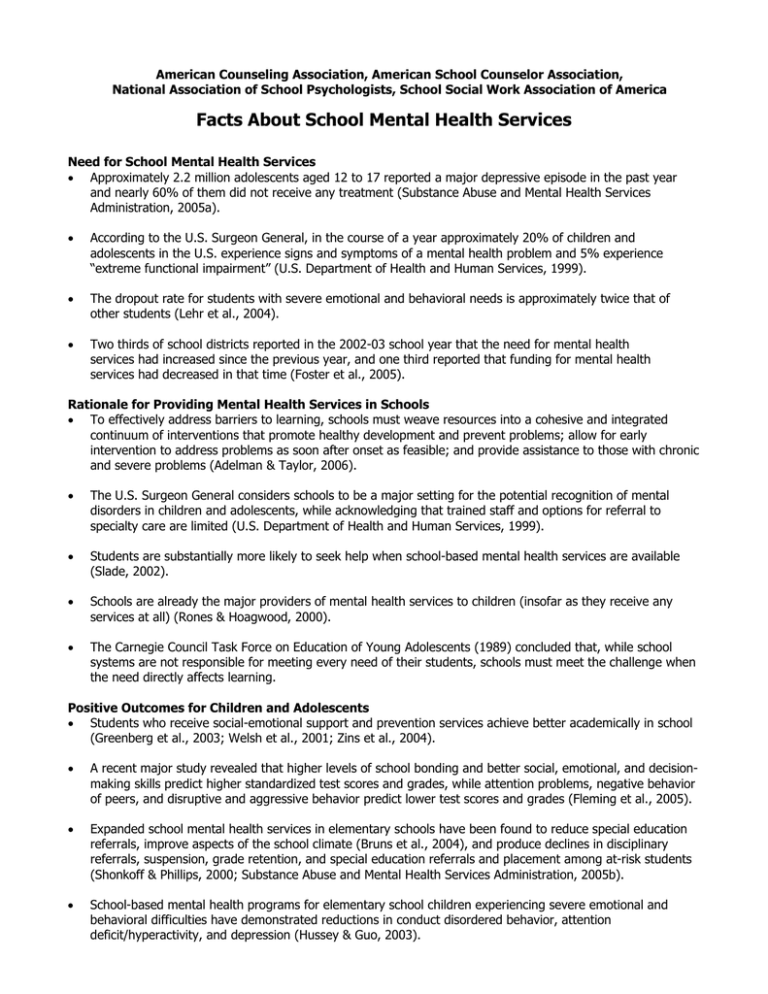
American Counseling Association, American School Counselor Association, National Association of School Psychologists, School Social Work Association of America Facts About School Mental Health Services Need for School Mental Health Services • Approximately 2.2 million adolescents aged 12 to 17 reported a major depressive episode in the past year and nearly 60% of them did not receive any treatment (Substance Abuse and Mental Health Services Administration, 2005a). • According to the U.S. Surgeon General, in the course of a year approximately 20% of children and adolescents in the U.S. experience signs and symptoms of a mental health problem and 5% experience “extreme functional impairment” (U.S. Department of Health and Human Services, 1999). • The dropout rate for students with severe emotional and behavioral needs is approximately twice that of other students (Lehr et al., 2004). • Two thirds of school districts reported in the 2002-03 school year that the need for mental health services had increased since the previous year, and one third reported that funding for mental health services had decreased in that time (Foster et al., 2005). Rationale for Providing Mental Health Services in Schools • To effectively address barriers to learning, schools must weave resources into a cohesive and integrated continuum of interventions that promote healthy development and prevent problems; allow for early intervention to address problems as soon after onset as feasible; and provide assistance to those with chronic and severe problems (Adelman & Taylor, 2006). • The U.S. Surgeon General considers schools to be a major setting for the potential recognition of mental disorders in children and adolescents, while acknowledging that trained staff and options for referral to specialty care are limited (U.S. Department of Health and Human Services, 1999). • Students are substantially more likely to seek help when school-based mental health services are available (Slade, 2002). • Schools are already the major providers of mental health services to children (insofar as they receive any services at all) (Rones & Hoagwood, 2000). • The Carnegie Council Task Force on Education of Young Adolescents (1989) concluded that, while school systems are not responsible for meeting every need of their students, schools must meet the challenge when the need directly affects learning. Positive Outcomes for Children and Adolescents • Students who receive social-emotional support and prevention services achieve better academically in school (Greenberg et al., 2003; Welsh et al., 2001; Zins et al., 2004). • A recent major study revealed that higher levels of school bonding and better social, emotional, and decisionmaking skills predict higher standardized test scores and grades, while attention problems, negative behavior of peers, and disruptive and aggressive behavior predict lower test scores and grades (Fleming et al., 2005). • Expanded school mental health services in elementary schools have been found to reduce special education referrals, improve aspects of the school climate (Bruns et al., 2004), and produce declines in disciplinary referrals, suspension, grade retention, and special education referrals and placement among at-risk students (Shonkoff & Phillips, 2000; Substance Abuse and Mental Health Services Administration, 2005b). • School-based mental health programs for elementary school children experiencing severe emotional and behavioral difficulties have demonstrated reductions in conduct disordered behavior, attention deficit/hyperactivity, and depression (Hussey & Guo, 2003). Cost/Benefit Analyses • The Institute of Medicine has reported that analyses of the economic costs and benefits of early childhood interventions for low-income children have demonstrated savings in public expenditures for special education, welfare assistance, and criminal justice (Shonkoff & Phillips, 2000). • Nearly $200 billion a year in economic losses could be recouped by raising the quality of schooling, investing more in education, and lowering dropout rates (Teachers College, Columbia University, 2005). • The Seattle Social Development Project, targeting behavior and attitudes of elementary students, provides an estimated net benefit of $9,837 per student in averted long-term social problems (Aos et al., 2004). • School-based drug abuse prevention programs have been conservatively estimated to provide $840 in social benefit per student, compared to a program cost of $150 per student (Caulkins et al., 2004). References Adelman, H.S. & Taylor, L. (2006). The current status of mental health in schools: A policy and practice brief. Los Angeles, CA: UCLA School Mental Health Project. Aos, S., Lieb, R., Mayfield, J., Miller, M., & Pennucci, A. (2004). Benefits and costs of prevention and early intervention programs for youth. Olympia, WA: Washington State Institute for Public Policy. Bruns, E. J., Walrath, C., Glass-Siegel, M., & Weist, M. D. (2004). School-based mental health services in Baltimore: Association with school climate and special education referrals. Behavior Modification, 28, 491-512. Caulkins, J. P., Liccardo Pacula, R., Paddock, S., & Chiesa, J. (2004). What we can—and cannot—expect from school-based drug prevention. Drug and Alcohol Review, 23, 79-87. Carnegie Council Task Force on Education of Young Adolescents. (1989). Turning points: Preparing American youth for the 21st century. Washington, DC: Author. Fleming, C. B., Haggerty, K. P., Brown, E. C., Catalano, R. F., Harachi, T. W., Mazza, J. J., & Gruman, D. H. (2005). Do social and behavioral characteristics targeted by preventive interventions predict standardized test scores and grades? Journal of School Health, 75, 342-349. Foster, S., Rollefson, M., Doksum, T., Noonan, D., Robinson, G., Teich, J. (2005). School mental health services in the United States, 2002-2003. DHHS Pub. No. (SMA) 05-4068. Rockville, MD: Center for Mental Health Services, Substance Abuse and Mental Health Services Administration. Greenberg, M. T., Weissberg, R. P., Utne O’Brien, M., Zins, J. E., Fredericks, L., Resnik, H., & Elias, M. J. (2003). Enhancing school-based prevention and youth development through coordinated social, emotional, and academic learning. American Psychologist, 58 466-474. Hussey, D. L., & Guo, S. (2003). Measuring behavior change in young children receiving intensive school-based mental health services. Journal of Community Psychology, 31, 629-639 Lehr, C. A., Johnson, D. R., Bremer, C. D., Cosio, A., & Thompson, M. (2004). Essential tools: Increasing rates of school completion: Moving from policy and research to practice. Minneapolis, MN: University of Minnesota, Institute on Community Integration, National Center on Secondary Education and Transition. Rones, M., & Hoagwood, K. (2000). School-based mental health services: A research review. Clinical Child and Family Psychology Review, 3, 223-241. Shonkoff, J. P., & Phillips, D. A. (Eds). (2000). From neurons to neighborhoods: The science of early childhood development. Committee on Integrating the Science of Early Childhood Development, Board on Children, Youth, and Families, National Research Council and the Institute of Medicine. Washington, DC: National Academy Press. Slade, E. P. (2002). Effects of school-based mental health programs on mental health service use by adolescents at school and in the community. Mental Health Service Research, 4, 151-166. Substance Abuse and Mental Health Services Administration. (2005a). Depression among Adolescents. The NSDUH Report. Rockville, MD: Author. Substance Abuse and Mental Health Services Administration. (2005b). Project ACHIEVE. SAMHSA Model Program Website: www.modelprograms.samhsa.gov/template_cf.cfm?page=model&pkProgramID=31 Teachers College, Columbia University. (2005, October). The social costs of inadequate education. Symposium conducted at Columbia University, New York. U.S. Department of Health and Human Services. (1999). Mental health: A report of the surgeon general. Executive summary. Rockville, MD: National Institute of Mental Health. Welsh, M., Parke, R. D., Widaman, K., & O'Neil, R. (2001). Linkages between children's social and academic competence: A longitudinal analysis. Journal of School Psychology, 39, 463-482. Zins, J. E., Bloodworth, M. R., Weissberg, R. P., & Walberg, H. J. (2004). The scientific base linking social and emotional learning to school success. In J. Zins, R. Weissberg, M. Wang, & H. J. Walberg (Eds.), Building academic success on social and emotional learning: What does the research say? (pp. 3-22). NY: Teachers College Press. For more information, please contact: American Counseling Association (703) 823-9800; American School Counselor Association (703) 683-2722; National Association of School Psychologists (301) 657-0270; School Social Work Association of America (847) 289-4527 or (202) 686-1637.
